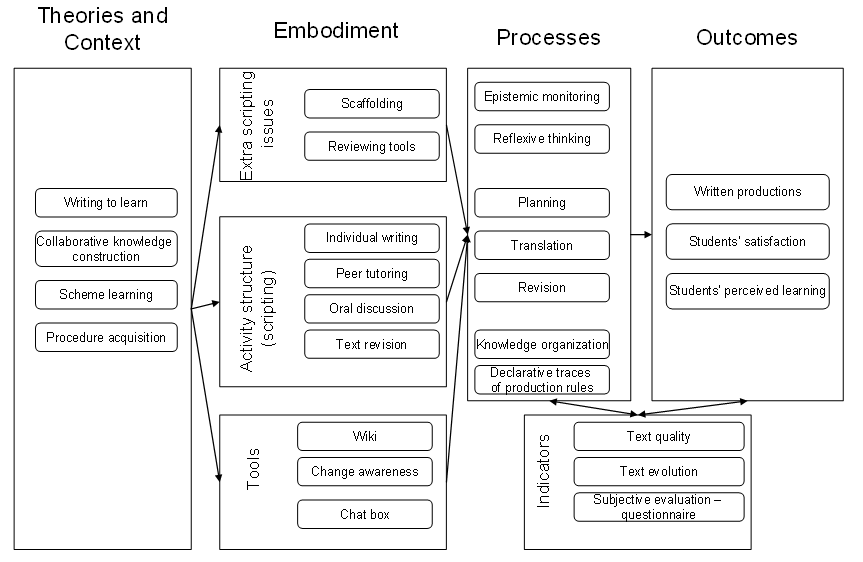Peer-to-peer learning: Difference between revisions
mNo edit summary |
m (→References) |
||
| Line 59: | Line 59: | ||
* Simon, Beth and Quintin Cutts (2012). Peer Instruction: A Teaching Method to Foster Deep Understanding, Communications of the ACM, Vol. 55 No. 2, Pages 27-29, DOI: 10.1145/2076450.2076459 | * Simon, Beth and Quintin Cutts (2012). Peer Instruction: A Teaching Method to Foster Deep Understanding, Communications of the ACM, Vol. 55 No. 2, Pages 27-29, DOI: 10.1145/2076450.2076459 | ||
* Topping, Keith J. "The effectiveness of peer tutoring in further and higher education: A typology and review of the literature." Higher education 32, no. 3 (1996): 321-345. | |||
[[Category: Learning theories]] | [[Category: Learning theories]] | ||
Latest revision as of 16:20, 27 January 2019
There are several variants, e.g.
- (some forms of) collaborative writing
- Peer tutoring
- learning by teaching (reciprocal teaching)
See also:
- Peer assessment
- When writing contributes to a larger collective body of knowledge whose elements can put in relation, we rather refer to a knowledge building community approach, as for example in the CSILE project.
Peer tutoring and collaborative writing
"Peer-tutoring" writing consists in assisting the revision process through the intervention of a peer, following the peer-tutoring assumption: Peer-tutoring is expected to enrich the production through the confrontation with other learners, and by fostering processes like metacognitive awareness on their own productions, particularly epistemic monitoring and reflexive thinking.
Peer tutoring is a process developed by Fantuzzo and his colleagues (Wolfe, Fantuzzo and Wolfe, 1986). It allows each student to play the role of tutor and tutored. Reciprocal peer tutoring allows each student to benefit from giving directions, evaluating and providing reinforcement for their partner. It creates mutual assistance and social support among participants (Fantuzzo, Riggio, Connelly and Dimeff, 1989; Pigott, Fantuzzo and Clement, 1986). Most of the time, research on peer tutoring provided evidence for its positive effects on performance, learning, reduction of stress and anxiety and an increase in satisfaction with the progress ( Riggio, Fantuzzo, Connelly and Dimeff, 1991). Still, little research has investigated the effects of peer tutoring for "writing to learn" activities (Gielen, Dochy, Tops, Peeters, 2007).
Here is a conjecture map summarizing some elements and relationships that may constitute a little peer collaborative writing activity that took place in a wiki.
Mazur Peer Instruction Model
According to Beth Simon and Quintin Cutts (2012), “in Peer Instruction, students gain preparatory knowledge before class (for example, through textbook reading) and complete a pre-lecture quiz to both incentivize their preparation and to give them feedback on whether they are ready to learn in a lecture format. During class, lecture is interspersed with or largely replaced by multiple choice questions (MCQs) and discussion. MCQs are designed by instructors to engage students in thinking about deep conceptual issues or common misconceptions. This is instantiated via a four-part process:
- Students individually consider a question and select an answer (typically reporting it via use of a clicker.
- Students discuss in preassigned groups.
- Students vote again on the same question.
- Classwide discussion follows led by student explanations and the instructor modeling their way of understanding the problem.”
Links
- Peer Tutoring by the International Writing Centers Association (retrieved oct 2012). Includes a good annotated Bibliography
References
- Bétrancourt, Mireille, Daniel Schneider, Monica Gavota et Urs Richle (2008), Project 2, dental assistants, in P. Dillenbourg (ed.) (2008). DUAL-T: Technologies for Vocational Training, Rapport intermédiaire, Federal Office for Professional Education and Technology. document pdf
- Fantuzzo, J. W., Riggio, R. E., Connelly, S., & Dimeff, L. A. (1989). Effects of reciprocal peer tutoring on academic achievement and psychological adjustment: A component analysis. Journal of Educational Psychology, 81, 173-177.
- Gielen, S., Filip Dochy, Liesje Tops, Elien Peeters (2007) Effects of formative peer-assessment on writing performance: What is the most beneficial role of the assessee in Proceedings of the 12th EARLI biennal conference on Research on Learning and Instruction, Aug. 28 - Sept. 1, Budapest (Hungary)
- Höysniemi, J., Hämäläinen, P., & Turkki, L. (2003). Using peer tutoring in evaluating the usability of a physically interactive computer game with children. Interacting with Computers, 15, 203-225.
- Johnson, R. T., & Johnson, D. W. (1988). Cooperative learning: Two heads are better than one. In Context. HTML, retrieved 14:53, 20 May 2008 (UTC).
- Kear, K. (2004). Peer learning using asynchronous discussion systems in distance education. Open Learning, 19(2), 151-164. Retrieved October 4, 2007
- Pigott, H. E., Fantuzzo, J. W., & Clement, P. W. (1986). The effects of reciprocal peer tutoring and group contingencies on the academic performance of elementary school children. Journal of Applied Behavior Analysis, 19, 93-98.
- Riggio, R. E., Fantuzzo, J. W., Connelly, S., & Dimeff, L. A. (1991). Reciprocal peer tutoring: A classroom strategy of promoting academic and social integration in undergraduate students. Journal of Social Behavior and Personality, 6, 387-396.
- Wolfe, J. A., Fantuzzo, J. W., & Wolfe, P. K. (1986). The effects of reciprocal peer management and group contingencies on the arithmetic proficiency of underachieving students. Behavior Therapy, 17, 253-265.
- Outhred, T, & Chester, A. (2010). The Experience of Class Tutors in a Peer Tutoring Programme: A Novel Theoretical Framework, Australasian Journal of Peer Learning, 3(1), 12-23. Available at: http://ro.uow.edu.au/ajpl/vol3/iss1/3
- Simon, Beth and Quintin Cutts (2012). Peer Instruction: A Teaching Method to Foster Deep Understanding, Communications of the ACM, Vol. 55 No. 2, Pages 27-29, DOI: 10.1145/2076450.2076459
- Topping, Keith J. "The effectiveness of peer tutoring in further and higher education: A typology and review of the literature." Higher education 32, no. 3 (1996): 321-345.
